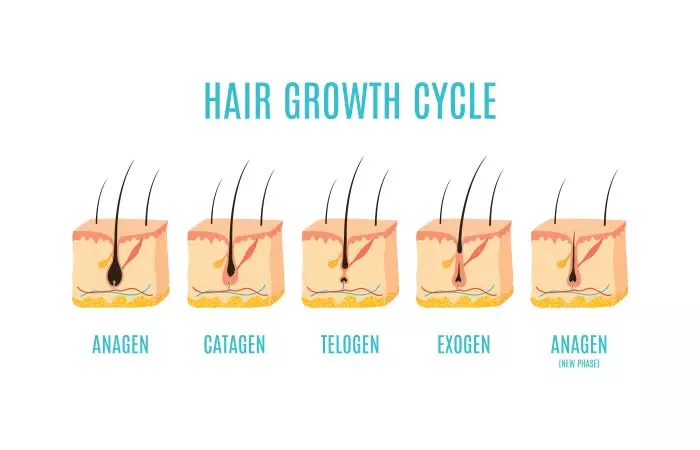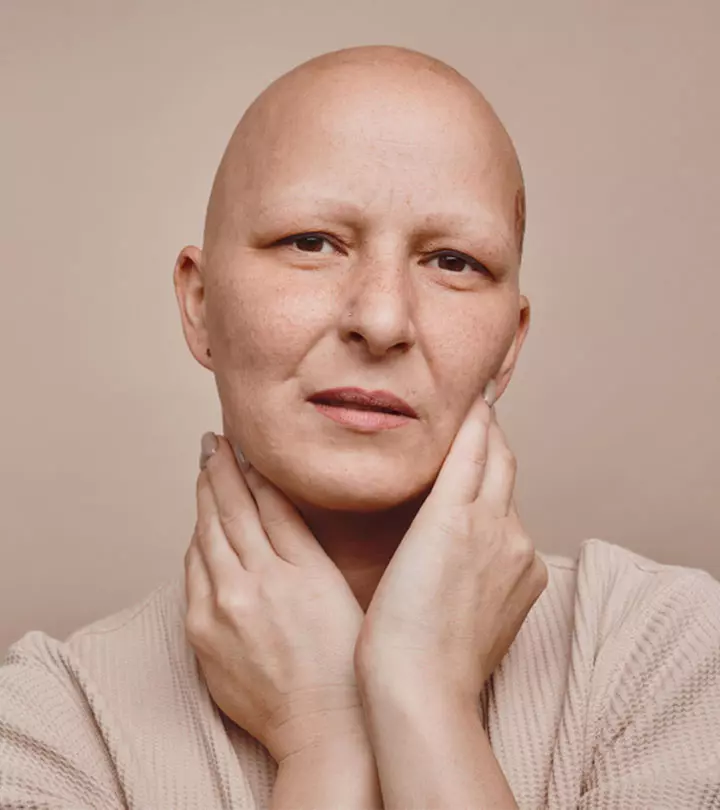Alopecia Areata Hair Loss – Causes, Symptoms, & Treatments
Figure out what's causing your hair loss to determine which treatment will suit you the best.

Image: Shutterstock
One of the most common hair problems that most people face is hair loss, specifically alopecia hair loss. Alopecia areata is a medical condition where the immune system attacks its own hair follicles. It can impact people of any age or gender, causing hair loss in unpredictable patterns. It is important for those affected to understand the condition since it can influence both physical appearance and emotional well-being. So, making a well-rounded approach to care and support is essential. Although it cannot be cured, you can rely on specific treatment methods to manage the condition.
The reasons for the onset of this condition are many, and there are different types of alopecia. Keep reading to know more about alopecia areata, its causes, treatment options, and possible ways to prevent it. Scroll down.
In This Article
What Is Alopecia Areata?
This graph from a 2018 study published in the Journal of the American Academy of Dermatology represents the monthly frequency of disease outbreaks in patients with alopecia areata, totalis, or universalis. There were 518 flares in total; November had the highest percentage (11.4%), followed by October (11.0%) and January (10.2%). The lowest percentage was recorded in the months of May (3.5%) and August (5.6%).

Flare Frequency By Month
Source: Seasonal patterns in alopecia areata, totalis and universalisA cross-sectional study was performed on 45,016 participants to assess the prevalence of alopecia areata, of which 511 self-reported having the condition using assessment tools. Of the self-reported cases, 104 (20.4%) participants uploaded photos of their condition for clinical evaluation. The clinical-adjudicated prevalence was estimated at 0.21% overall, 0.12% for mild cases, and 0.09% for moderate-severe cases.
Alopecia areata is an autoimmune disorder that affects about 25% of the general population (1). It is characterized by non-scarring hair loss that preserves the hair follicle but without any hair shaft growth. It can be seen as patchy or diffuse hair loss. Alopecia areata affects the bulb of the hair follicle, causing the immune system to fight against its growth (anagen). Genetics is the most common cause for alopecia areata. This condition causes patchy bald lesionsi An abnormal change in the appearance of the skin of tissue inside or outside the body, which may or may not be cancerous. that may eventually lead to a complete loss of hair on the scalp.
Key Takeaways
- Alopecia areata causes hair loss and the appearance of bald patches.
- It halts the development of hair shafts in the hair follicles and sheds the existing hair shafts at a quicker rate.
- Genetic factors, atopy, trauma, and stress are some factors that may cause alopecia aerate.
- Natural remedies like onion juice and walnut oil may help with treating this problem.
- Reduce the use of excessive chemical products, follow a healthy diet and avoid tight hairstyles, to prevent or slow down hair loss.
What Happens When You Have Alopecia Areata?

The regular hair growth cycle happens in four phases – anagen, catagen, telogen, and neogen/exogen. In the anagen phase, the hair shafts grow from the hair follicles. Catagen is a regression period, while telogen is the resting phase. Exogen/neogen is the phase where the older hair shafts fall off and newer hair shafts grow from the follicle. Losing up to 100 strands a day is normal. Anything beyond this could mean a case of severe hair loss.
Alopecia areata is characterized by a rapid progression of follicles from the anagen phase to the catagen and telogen phases. This causes the hair shafts to fall out and leaves the affected follicles in a state of prolonged anagen (2). The development of new hair in the affected hair follicles is halted.
Quick Facts
- Alopecia areata is the most common type of alopecia.
- It is a type of non-scarring hair loss.
- Alopecia is more common in men. In women, this condition seems to be more frequent in those over 45 years of age.
- The name “alopecia areata” was coined by Sauvages. The first clinical description of alopecia areata dates back to 14-37 BC (3).
- Alopecia areata accounts for 2% of the dermatology cases in the USA and the UK, 3.8% cases in China, and 0.7% cases in India (4).
Claire, a blogger, discussed the changes she made to stop losing hair due to alopecia areata, focusing on dietary adjustments, supplements, reducing chemical exposure, managing stress, and hair care practices. She emphasizes the importance of conscious living for a positive impact on overall health and hair regrowth, stating, “I no longer treat myself once the hair loss becomes bad enough to notice. I manage my health every day .(i)”
Alopecia areata can occur in different types, which we will explore in the upcoming section.
What Are The Types Of Alopecia Areata

- Patchy Alopecia Areata: One or multiple distinct or joined patches of hair loss.
- Alopecia Totalis: Total loss of hair on the scalp.
- Alopecia Universalis: Total loss of hair on the body.
- Alopecia Incognita: Total loss of hair in a diffuse manner. It is diagnosed with a pull test, yellow dots, short and miniature hair regrowth, and a lack of nail development.
- Ophiasis: Hair loss occurring in a band-like shape along the circumference of the head, specifically near the ears and back of the head.
- Sisaipho: Chronic alopecia that occurs everywhere except the border of the scalp.
- Marie Antoinette Syndrome: A sudden “overnight” graying of hair paired with an episode of acute diffuse alopecia. This type of hair loss is more common with pigmented hair.
- Reticular Alopecia Areata: Patches of alopecia occurring with well-preserved narrow bands of hair in between (3).
- Diffuse Alopecia Areata: Widespread and acute hair loss, which is commonly mistaken for androgenic alopeciai Permanent hair loss from the scalp in both men and women due to excessive response to androgens. or chronic telogen effluvium (3).
Alopecia areata has multiple causes. We have covered them in detail in the following section.
Causes Of Alopecia Areata

- Genetic Factors: The most prevalent cause of alopecia areata appears to be genes. Alopecia affects twins, siblings, and generations of families with affected individuals. Single genes that are commonly associated with related autoimmune disorders have shown to play a role in alopecia areata.
- Autoimmune Disorders: Autoimmune disorders like vitiligoi A condition in which the skin loses its pigment in patches on the body as pigment-producing cells stop functioning. , lupusi An inflammatory disease in which the immune system attacks its own tissues and causes joint pain, fever, and rash. , and thyroid issues have been found to cause alopecia areata. Research shows that alopecia is four times more likely to develop in individuals with vitiligo (3).
- Auto-antibodies: Auto-antibodies have been noticed quite frequently in those dealing with alopecia areata. These antibodies induce anti-follicular activity and may even cause follicular inflammation (3).
- Cellular Immunity: Certain lymphocytes (a type of immune cells) may release cytokines that prevent follicular growth and inhibit hair synthesis (3).
- Atopy: Atopic diseases are commonly associated with early-onset and chronic forms of hair loss. Atopic diseases like sinusitisi A condition in which the lining of sinuses or cavities around the nasal passage becomes inflamed triggered due to cold or allergies. , asthma, rhinitisi Irritation and swelling of the mucous membrane in the nose, which causes chronic sneezing, runny nose, and congestion. , and atopic dermatitisi A chronic condition that causes dry, itchy, inflamed skin and usually develops during childhood. Also known as eczema. are common in people with alopecia areata (1). In Korea, patients with atopic diseases also had an early onset of alopecia areata.
- Trauma And Stress: Psychological trauma and emotional stress can cause alopecia areata. Stress and trauma produce neuromediators that may inhibit hair growth (3).
- Nutrient Deficiency: In a study, 24-71% of women with alopecia areata were found to have iron deficiency (5). Low zinc levels were also observed in patients with alopecia areata (6).
In the following section, we discuss the signs and symptoms of alopecia areata.
Symptoms

Here are some of the signs and symptoms of alopecia areata.
- Exclamation point hairs seen at the margins.
- Oval or round bald patches that appear on the scalp.
- The bald patches become smooth.
- Hair loss on different parts of the body.
- Appearance of new and larger bald spots that may join prior bald regions.
- Production of oil in areas with affected hair follicles.
If you experience one or more of these symptoms, consult a doctor for a professional diagnosis.
Diagnosis

A case of alopecia areata can be confirmed by a biopsy and a trichogram.
- Biopsy: A biopsy determines the exact type of hair loss that occurs. A good sample of pillar follicles is extracted with a bistoury.
- Trichogram: Some hair is extracted from the border of a bald patch. This hair is checked to determine its growth phase.
Doctors might also perform a pull test (where hair is gently tugged to check if any hair is shed).
Treatments
Natural Treatments:
Alopecia areata has many natural forms of treatment. These treatments are said to have fewer to no side effects (7).
- Ginkgo biloba or Indian gooseberry mixed with coconut oil can be used to stimulate hair growth.
- Onion juice can be applied to hair by itself or paired with honey to stimulate hair growth and combat dandruff.
- Rosemary and lavender oils can be mixed with a carrier oil and massaged into the scalp to stimulate hair follicles.
- Walnut oil can be applied to hair roots and massaged into the scalp to promote hair growth.
- A paste of licorice, milk, and a pinch of saffron can be applied to hair and left overnight. This is an effective treatment for hair loss that may stimulate hair growth.
- Using hair packs and masks made of natural ingredients may improve hair health and prevent hair thinning.
Medications
Medications like topical minoxidil, topical tretinoin, rubefacienti A topical substance that causes redness in the skin by dilating capillaries and increasing blood circulation. , corticosteroids, intralesional infiltrations, anthralin, diphencyprone and cyclosporin might be prescribed to combat alopecia areata. However, these drugs can have side effects like hyperpigmentation. Immunotherapy and Puva therapy might also be recommended.
Aromatherapy
Aromatherapy may be an effective treatment for alopecia.
The oils extracted from rosemary, thyme, lavender, wolf’s bane, basil and others may stimulate hair growth.
Nutrient Supplementation
Minerals and vitamins play an important role in hair growth (8). A deficiency of minerals and vitamins can induce hair loss. Minerals like calcium, iron, copper, magnesium, iodine, and zinc support hair growth. Vitamins B3, B5, and folic acid, and vitamins A, C and E may improve hair health.
Note: Take nutrient supplements in prescribed doses. Excess supplementation may cause hair damage.
Food Habits
Overconsumption of vitamins and minerals can also cause hair loss. Many supplements often surpass the recommended dosage and may cause potential damage. The best way to ingest these nutrients is through your food. Eggs, yogurt, soy, green vegetables, nuts, carrots, fruits, etc. are all excellent sources of minerals and vitamins that aid body and hair health.
Apart from these treatment options, you also may follow certain tips to help prevent or slow down hair loss.
Prevention Tips
- Reduce the use of products with excessive chemicals as they can damage your hair.
- Regular exercise and yoga can help relieve stress and may help prevent associated alopecia areata.
- A healthy diet impacts your hair growth. Eat right and reduce the intake of processed foods.
- Opt for natural and organic hair care products, packs, and masks. Many natural ingredients are known to help stimulate hair growth and prevent hair loss.
- Massaging the scalp can stimulate hair growth by improving blood circulation (9). Massage your scalp with some warm oil once a week to promote hair growth.
In addition to these prevention tips to keep in mind, here are some things you should avoid if you have alopecia areata.
Things To Avoid When You Have Alopecia Areata
- Tight Hairstyles: Hairdos like high ponytails, cornrows, and tight braids can put unwanted pressure on the hair follicles and worsen hair loss.
- Chemical Treatments: Refrain from getting chemical treatments like perms, keratin treatments, and hair coloring as they can lead to further damage to the fragile hair.
- Excessive Scratching: Avoid rubbing or scratching the scalp as it can irritate the sensitive hair follicles.
- Excessive Heat Styling: Frequently using heat styling tools like curling rods and flat irons, especially without heat protectant, can further weaken the hair.
 Quick Tip
Quick TipCan Alopecia Areata Be Reversed?
Alopecia areata pushes hair follicles into a prolonged anagen phase and halts the hair follicle development. While the hair follicles are not damaged, they need to be restimulated to promote hair growth. Regular hair maintenance and the right treatments may help reduce alopecia areata, and hair may regrow in certain areas. However, more research is warranted in this regard. If hair regrowth is not stimulated, one may opt for hair transplantation and restoration therapies.
Note: Living with alopecia areata can be tough, both physically and emotionally. It helps to reach out for support from others who understand what you are going through, whether it is friends, support groups, or a counselor. Sharing experiences with others can ease feelings of loneliness and offer helpful ways to manage the emotional challenges of hair loss.
Infographic: Alopecia Areata: Causes And Treatments
Alopecia areata is a disease where your immune system attacks the hair follicles, leading to hair loss and bald patches. While there is no cure for this condition, understanding the causes behind it can help your doctor tailor your treatment to help manage it properly. Scroll down and check out the infographic below to know more!
Some thing wrong with infographic shortcode. please verify shortcode syntaxAlopecia areata is a form of hair loss that results in bald patches on the scalp. This condition may be caused due to an autoimmune response or, in some cases, due to genetics. Alopecia hair loss treatment can be natural or medication-based. Your healthcare provider may recommend a course of corticosteroids and topical minoxidil to soothe alopecia. Your locks may take some time to recover and regrow, but if you treat the condition gently and steadily, you should not suffer long-term damage. With the right approach, it is possible to effectively manage alopecia and maintain healthy hair and improve your scalp condition. However, if you are bothered by the bald patches or are feeling self-conscious, you can try wearing wigs or getting a hair transplant.
Frequently Asked Questions
Is alopecia areata serious?
The seriousness of alopecia areata as a hair fall condition is determined by factors such as the extent of the baldness and its psychological impact. Feelings of anxiety, sadness, or a drop in self-esteem are to be expected. Many people may feel uncomfortable about how they look, which can impact their confidence and social life. Alopecia areata causes minimal physical discomfort but can affect mental health significantly.
What is the difference between alopecia areata and alopecia?
Alopecia is an umbrella term for all the different types of alopecia. Alopecia areata is a type of alopecia.
Does alopecia worsen with age?
Not necessarily. Alopecia can develop at any age due to multiple factors. It is most commonly seen in people under 40 years of age (1).
Is garlic good for alopecia areata?
Yes, studies indicate that garlic may stimulate hair growth in people with alopecia (10).
Does turmeric help with alopecia?
Yes, curcumin, the active ingredient in turmeric, in combination with piperine and capsaicin may help stimulate hair growth (11). Ensure that you conduct a patch test before using turmeric.
Some thing wrong with illustration image shortcode. please verify shortcode syntaxReferences
Articles on StyleCraze are backed by verified information from peer-reviewed and academic research papers, reputed organizations, research institutions, and medical associations to ensure accuracy and relevance. Read our editorial policy to learn more.
- Alopecia Areata
https://www.ncbi.nlm.nih.gov/pmc/articles/PMC5573125/ - Alopecia Areata: Alter ations in the Hair Growth Cycle and Correlation With the Follicular Pathology
https://pubmed.ncbi.nlm.nih.gov/3954954/ - Alopecia Areata: a Revision and Update
https://www.scielo.br/j/abd/a/vXCLdmVdz8ct6qzkmjBCSyd/?format=pdf&lang=en - Etiopathogenesis of Alopecia Areata
https://www.longdom.org/open-access/etiopathogenesis-of-alopecia-areata-2167-0951.1000123.pdf - The Diagnosis and Treatment of Iron Deficiency and Its Potential Relationship to Hair Loss
https://pubmed.ncbi.nlm.nih.gov/16635664/ - Zinc and Its Status in Some Dermatologic Diseases–A Statistical Assessment
https://pubmed.ncbi.nlm.nih.gov/3442079/ - Alopecia: Herbal Remedies
https://www.researchgate.net/publication/215800523_ALOPECIA_HERBAL_REMEDIES - The Role of Vitamins and Minerals in Hair Loss: a Review
https://www.ncbi.nlm.nih.gov/pmc/articles/PMC6380979/ - Standardized Scalp Massage Results in Increased Hair Thickness by Inducing Stretching Forces to Dermal Papilla Cells in the Subcutaneous Tissue
https://www.ncbi.nlm.nih.gov/pmc/articles/PMC4740347/ - TREATMENT OF ALOPECIA AREATA WITH TOPICAL GARLIC EXTRACT
https://www.researchgate.net/publication/260656650_TREATMENT_OF_ALOPECIA_AREATA_WITH_TOPICAL_GARLIC_EXTRACT - Efficacy of a mixed preparation containing piperine, capsaicin and curcumin in the treatment of alopecia areata
https://onlinelibrary.wiley.com/doi/abs/10.1111/jocd.14931
Read full bio of Dr. Shruti Chavan
Read full bio of Anjali Sayee
Read full bio of Ramona Sinha
Read full bio of Swathi E



























Community Experiences
Join the conversation and become a part of our empowering community! Share your stories, experiences, and insights to connect with other beauty, lifestyle, and health enthusiasts.